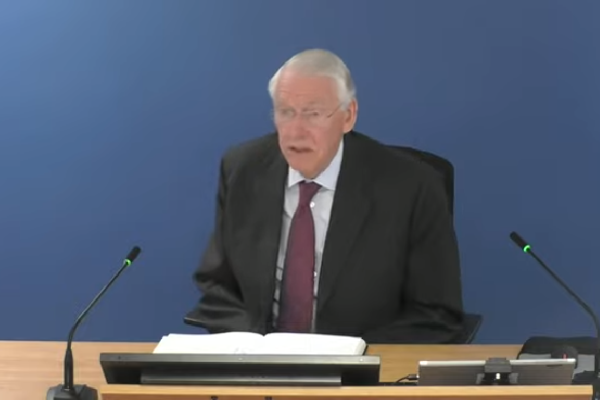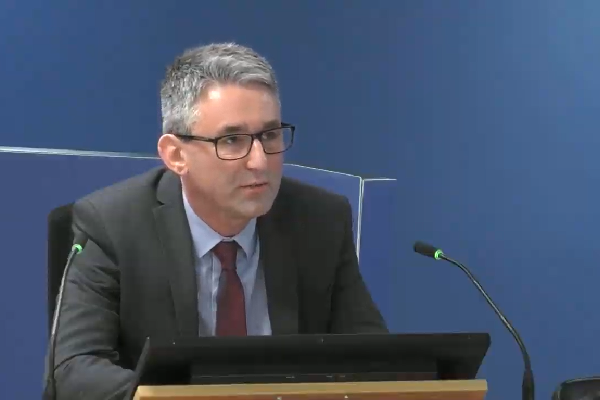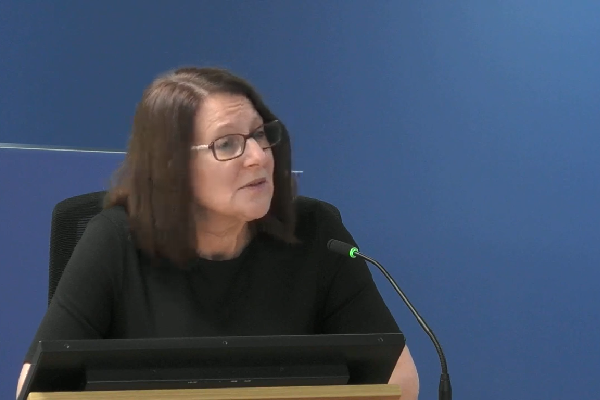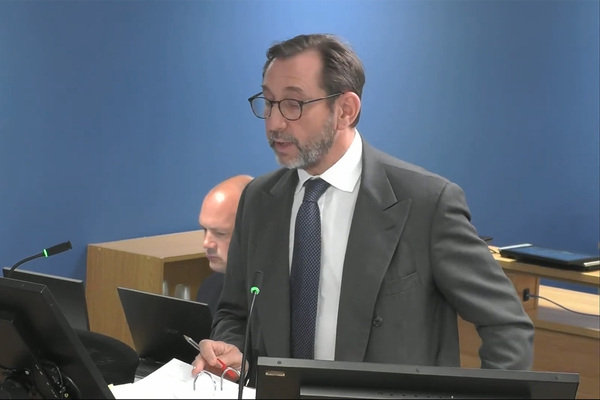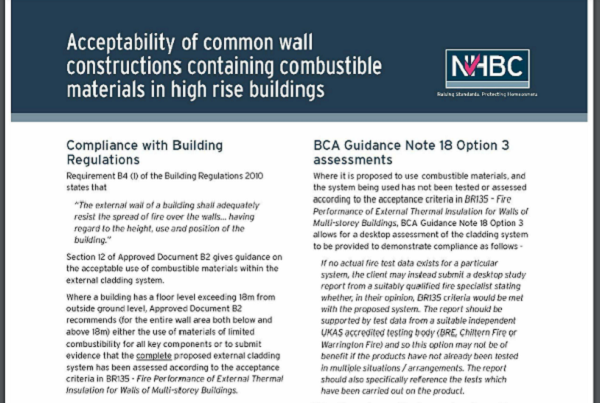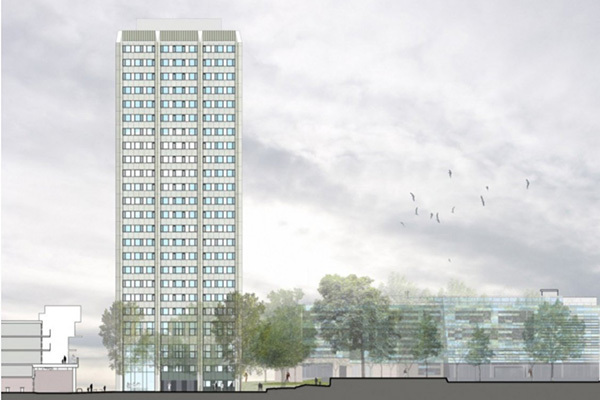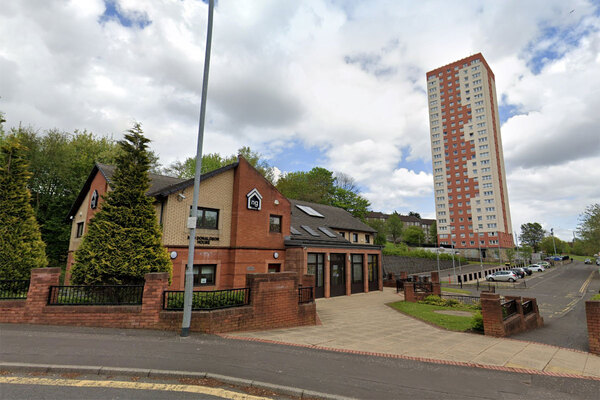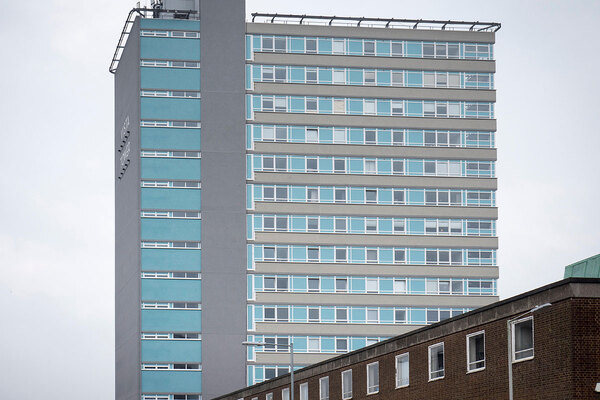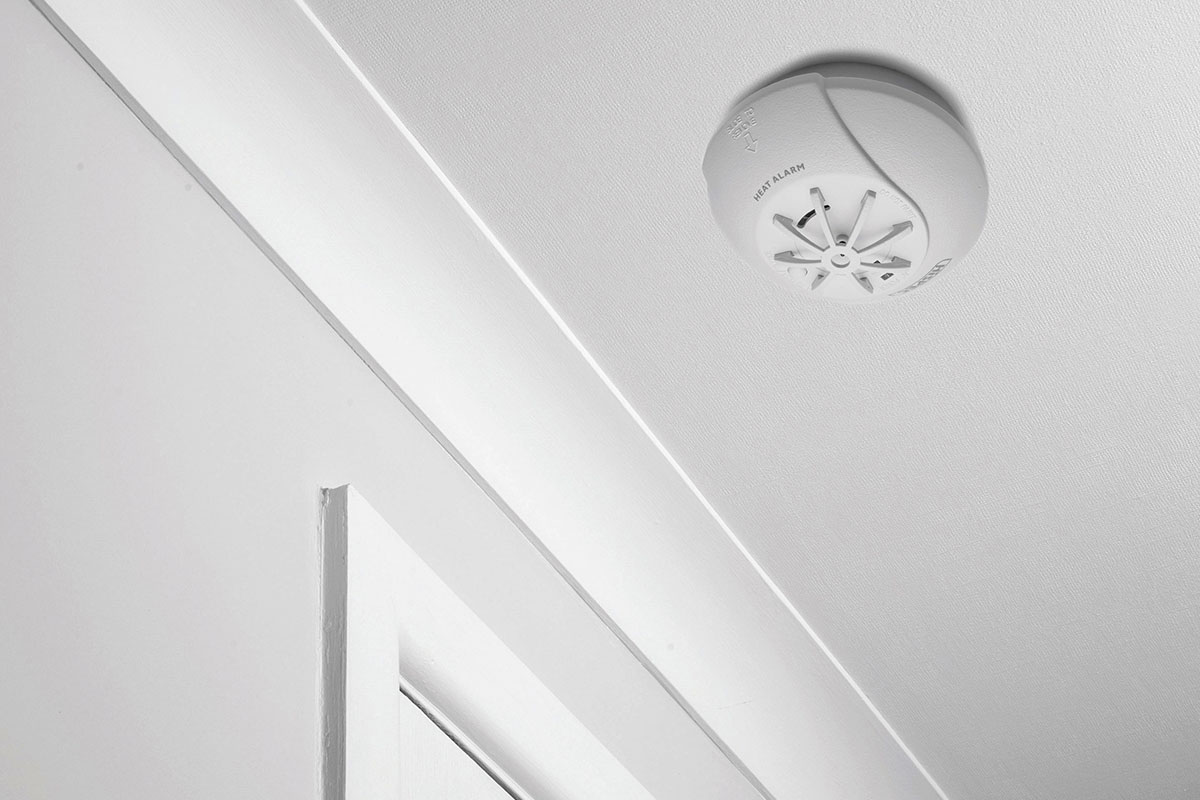Grenfell Tower Inquiry diary week 62: ‘Did it ever occur to you that this act of collaboration was, in one sense, corrupting?’
The Grenfell Tower Inquiry returned to the work of the National House Building Council (NHBC) this week, with a new shocking revelation about the government’s actions in the immediate aftermath of the fire. Peter Apps reports
This week the Grenfell Tower Inquiry returned to the topic it was examining before Christmas: the role played by the NHBC in the development of what we now call ‘the cladding crisis’.
To recap: the NHBC is the country’s largest building control inspector, which means it provides builders with completion certificates certifying that their project has complied with regulations.
With almost half of the country’s residential projects coming under its eyes, its interpretation of regulations is important and influential in deciding what actually ends up on our buildings.
As we have seen over the past few weeks of evidence, this interpretation appears to have helped ease the passage of combustible materials onto high-rise buildings around the UK.
We will pick up the story in 2013.
‘So it was a slavish following of a piece of paper, really, to put it unkindly?’
As the inquiry has previously established, insulation manufacturer Kingspan had been selling its combustible K15 insulation for high-rise projects since 2006.
This was despite guidance requiring the higher standard of ‘limited combustibility’ or that the entire cladding system build up had passed a large-scale test.
Kingspan had passed one such test, but this test used a system with heavy cement-fibre boards. It was selling its insulation for a far wider range of systems and the NHBC had been signing them off. Why?
The answer given by the witnesses this week was that a certificate written by the British Board of Agrément (BBA), a respected third-party certifier of construction products.
This certificate said K15 could be used in accordance with the passage in building guidance which demanded limited combustibility and could also be used in a range of systems providing the builder sought advice from Kingspan as to compliance.
As the inquiry has heard previously, this certificate was deeply flawed and a consequence of “very basic failures of due diligence” on the part of the BBA.
But the NHBC witnesses said they were entitled to rely on it. “I saw no reason to challenge the credibility of a BBA certificate,” said Diane Marshall, operations director at the NHBC.
“But it was incredible on its face, surely, wasn’t it?” asked lead counsel to the inquiry Richard Millett QC.
“No,” replied Ms Marshall. “The standing of a BBA certificate in the industry is well regarded.”
“Even if it says the moon is made of green cheese?” asked Mr Millett.
Surely the instruction to contact Kingspan regarding compliance placed too much power in the hands of the manufacturer?
“If we read this certificate as saying, ‘go and ask the manufacturer whether the product is suitable’, where’s the independence?” asked inquiry chair Sir Martin Moore-Bick.
“I can see how that would be viewed, but that was the view within the industry, that a BBA certificate could be held in that regard,” replied Ms Marshall.
“So it was a slavish following of a piece of paper, really, to put it unkindly?” asked Sir Martin.
“Well, a piece of paper produced by an accredited body that was well recognised,” said Ms Marshall.
But questions about this piece of paper were starting to mount.
‘As we learned more about Kingspan, we learned that their knowledge base was very limited’
In October 2013, facade engineering consultancy Wintech contacted the NHBC to question its approval of K15.
In an email it warned that the product “does not meet the requirements of the building regulations” and should not be used “without… test data to confirm its acceptability”.
This was a problem for the NHBC. They had already accepted the product on hundreds of buildings and their clients expected it to be approved.
Internal emails showed staff members warning of a “a major issue with our customers” and a “barrage of enquiries” if they stopped approving its use.
“Did NHBC continue to accept K15 in order to avoid the barrage of enquiries?” asked Mr Millett.
“No,” said John Lewis, a former senior fire engineer at the organisation. “NHBC… wasn’t afraid of tackling difficult subjects.”
Mr Lewis contacted Kingspan to ask for more details about why its product was acceptable for use on high-rise buildings. But he was not impressed with the response.
“As we learned more about Kingspan, we learned that their knowledge base was very limited,” he said in his witness statement. He learned that the firm only had one successful test and they placed heavy reliance on the BBA certificate.
But in December 2013, the concerns about the certificate had reached the BBA and the firm amended it by removing the reference to contacting Kingspan and the claim that the product could be used in accordance with official guidance.
The NHBC found out about this change in January 2014. It asked Kingspan for further testing to prove the suitability of its product. Kingspan promised to do so.
But the NHBC now needed to decide whether or not to keep accepting products in the meantime.
‘Why not stop, unless it was something to do with trouble with customers?’
The argument of Mr Lewis and Ms Marshall was that they did not need to stop accepting K15 immediately.
Projects that had started before December 2013 were covered by the prior BBA certificate. Those which started from January 2014 onwards would not complete for some time. This left a gap for Kingspan to produce further testing which would justify the product’s use.
“Was the fact that refusing K15 might cause ‘a major issue’, or a ‘barrage of enquiries’... a factor in the decision − your decision − to continue to accept K15 on tall buildings, at least in the meantime?” Mr Millett asked Ms Marshall.
“No. At the end of the day, we want to achieve compliant buildings,” she said.
“Yes, but here was a real risk that buildings that you were approving weren’t. So why not stop, unless it was something to do with trouble with customers?” asked Mr Millett.
“No, the customer angle had no consideration, it was about compliance with whatever route was available,” Ms Marshall replied.
‘Did it ever occur to you that this act of collaboration was, in one sense, corrupting’
While it was waiting for Kingspan to provide further testing evidence, the NHBC also led a group of building control professionals represented by the Building Control Alliance (BCA) to try and find a solution to the problem.
This resulted in the publication in July 2014 of ‘Technical Guidance Note 18’. This offered three ways for a cladding system to comply with the building regulations.
The builder could either use materials of limited combustibility, test their proposed build-up in a large-scale test, or submit a desktop study from an accredited test house affirming that if a product was tested it would comply.
This last route has been deeply controversial since Grenfell. This week’s witnesses insisted official guidance allowed existing test data to be used to infer whether or not an untested system should pass.
But should this have been applied to the complex area of combustible facades, where small changes can make a big difference?
Mr Millett pointed to passages in the rules on testing which said the results were only relevant to the specific system tested.
“Do you accept that these paragraphs are completely inconsistent with the existence of [desktop studies for cladding systems]?” he asked Mr Lewis.
“If we had implemented [the guidance] rigidly as per what you’re saying here, then nothing would have been allowed to be built because there were only four [successful] tests and that would have been all the construction industry could build on high-rise buildings,” he said.
He accepted that an alternative would simply have been not to use combustible materials.
Mr Lewis also accepted that the firm ultimately wanted to find a solution because it wanted to “collaborate” with rather than “hold up the industry”.
“Building control as a profession had wanted to move on from the days of, you know, being very rigid to a point where it was collaborative,” said Mr Lewis.
“Did it ever occur to you that this act of collaboration was, in one sense, corrupting, because it would undermine the ruthless and fearless independence of the regulator?” said Mr Millett.
“Well, I think we probably knew that, but, you know… I can’t give any more reasons, really. That was the thinking of the industry at the time,” replied Mr Lewis.
‘By this point, you now had strong suspicions that Kingspan were concealing failed test reports’
As 2014 wore on, Kingspan were unable to provide the portfolio of tests the NHBC had been hoping for.
And concern about the suitability of the product was not going away. In fact, the issue had reached the ears of a senior government official: Brian Martin.
Mr Martin, who was responsible for the building regulation guidance covering fire safety, wrote to the NHBC with what he described as a “friendly warning”.
“Allegedly − several buildings have been erected where PIR [polyisocyanurate] insulation has been used in cladding panels well over 18m in height. Apparently people are under the impression that PIR is a material of limited combustibility (which it isn’t),” he wrote. “Again, allegedly, many of these buildings are blocks of flats.”
The NHBC responded, setting out the situation with K15. It added: “There is no reason to suspect that buildings which have been built with Kingspan K15 are at risk at this time, it is just the fact that the testing carried out to date does not bear this out.”
But what basis did the NHBC have for asserting this?
“Given that, I think, hundreds of buildings that had used K15 above 18m had not used it in the one, sole, single specified tested construction which the BBA certificate spelt out, how could you possibly say that there was no reason to suspect risk?” Mr Millett asked Ms Marshall.
“Again, on the basis of a valid BBA certificate,” said Ms Marshall.
In autumn 2014, in an email to a friend at another building control firm, Mr Lewis described the product as “an accident waiting to happen”.
“Did your colleagues at NHBC share the view… that it’s all an accident waiting to happen?” asked Mr Millett.
“I believe they − everyone at NHBC – knew that this was not a good situation,” said Mr Lewis.
He would add in another email in summer 2015 that he had heard of a test Kingspan carried out with a cladding manufacturer using solid aluminium panels that failed in 15 minutes, with flames going over the top of the test rig.
He said Kingspan had never mentioned this test to NHBC and had threatened the cladding manufacturer with legal action if they ever mentioned it.
“Do we get from that, Mr Lewis, that by this point, early August 2015, you yourself now had strong suspicions that Kingspan were concealing failed test reports?” asked Mr Millett.
“Yes,” replied Mr Lewis.
This was particularly concerning because the NHBC was still signing off K15. In January 2014, it had written to Kingspan threatening to withdraw its approval of the product for high rises.
But the manufacturer responded with a threat of legal action and the NHBC backed down. Instead, it said it would only accept it with the support of a desktop study. But this position was to be further watered down.
‘It was a dangerous mistake on the part of the NHBC designed to go back to business as usual and at the expense of life safety’
In July 2016, the NHBC hosted a conference on tall building facades. Placed on the chair of each delegate was a new guidance document.
This document had been written by Mr Lewis and it outlined “common wall assemblies”, which the NHBC would accept without even asking for a desktop study.
It listed Kingspan K15 as an acceptable insulation material, as well as Celotex RS5000. For the exterior cladding, one of the options was aluminium composite material (ACM), providing it had a ‘Class B’ certificate.
This combination is precisely what was used on Grenfell Tower during the refurbishment.
Although the NHBC had no role in signing off the tower, and this guidance was not consulted by the local authority surveyor who did, it still appears to be startling evidence of the permissive attitude taken by building control at the time.
Mr Lewis explained that the guide was based on the large number of desktop studies NHBC had seen to this point. “We took the view that, you know, all we’re going to get on every building hereon is the same report saying the same thing,” he said.
He accepted that the guide was essentially “inference based on underlying assessments, which are themselves inferences from underlying data”.
He said the process of approving desktop studies for every individual project had become “very time consuming” and there was a “desire to move to a more business as usual footing”.
One major issue with the document was its apparent acceptance of ACM: the violently combustible cladding panel which had been linked to several huge fires worldwide.
Mr Lewis and Ms Marshall said the intention was not to accept the most dangerous type of ACM, which has a 100% polyethylene (PE) core, but only the less combustible version where it is diluted with non-combustible materials.
However, the guidance did not say this explicitly. Instead it appeared to say either type could be used, provided it had a Class B certificate.
“I thought that that was then clearly going to exclude all the 100% PE−cored ACM materials which, as far as we knew, would achieve nowhere near a Class B,” said Mr Lewis.
But he accepted he had not done any research to confirm this. Had he done, he may have learned that the panels used on Grenfell Tower were being sold with a certificate which claimed they met precisely this classification.
“Let me suggest to you that… [this note] was a dangerous mistake on the part of the NHBC designed to go back to business as usual and at the expense of life safety. What do you say to that?” asked Mr Millett.
“I have to agree, it shouldn’t have been written. We shouldn’t have done it,” replied Mr Lewis.
Asked the same question, Ms Marshall said she did not agree. “I think the knowledge at the time allowed us to produce the guidance note for our customers based on the evidence that we had,” she said.
‘Did you consider it appropriate that a government official was approaching you with a pre-prepared script in support of government after the Grenfell Tower fire?’
Finally, this week the inquiry delivered a shocking new revelation about the government’s actions in the immediate aftermath of the fire.
On 16 June 2017, two days after the blaze, Mr Martin emailed Ms Marshall about an article which had run in The Times suggesting building guidance permitted the use of the cladding used on Grenfell Tower.
Mr Martin had been asked to rebut this and wanted Ms Marshall to help. “I’ve also been asked if an independent expert would be willing to say this (or something similar) in public? Can you consider the attached and let me know please,” he wrote in an email.
He attached a script which explained the government’s line on why the guidance in fact banned the use of the material.
“Did you consider it appropriate that a government official was approaching you with a pre-prepared script in support of government after the Grenfell Tower fire?” asked Mr Millett.
“I think it was unusual,” replied Ms Marshall.
“But did you think it was appropriate?” asked Mr Millett
“I don’t know if I considered it at the time,” she replied.
She ultimately suggested Mr Martin should approach the BCA for a “more independent” view.
Was her reluctance to engage due to the NHBC’s own guidance document which apparently allowed the use of ACM? Ms Marshall insisted it was not.
The inquiry continues, with evidence from the UK Accreditation Service continuing next week.
Grenfell Tower Inquiry – week 62 headlines
Government officials sought “independent experts” willing to follow a “pre-prepared script’ defending their official guidance from media criticism two days after the Grenfell Tower fire, new emails released by the inquiry reveal.
NHBC ‘should not have written’ dangerous cladding guidance former fire engineer accepts
The UK’s largest building control inspector should not have written “dangerous” guidance which endorsed the use of combustible cladding products, its former senior fire engineer said.
NHBC suspected Kingspan was ‘concealing failed fire tests’ before Grenfell
A senior fire engineer at the UK’s largest building control inspector had “strong suspicions” that large insulation manufacturer Kingspan was “concealing” failed fire test reports, but continued to accept the use of their product on high-rise buildings.
NHBC fire engineer accepts ‘corrupting’ influence of desire to collaborate with industry
A former surveyor at the National House Building Council has accepted that a desire to “collaborate” with industry over its use of combustible insulation was a “corrupting” influence for a firm required to enforce fire safety regulations.
Sign up for our weekly Grenfell Inquiry newsletter
Each week we send out a newsletter rounding up the key news from the Grenfell Inquiry, along with the headlines from the week
Already have an account? Click here to manage your newsletters
Grenfell Tower Inquiry phase two: weekly diaries
Module one: the refurbishment
Week one: A vivid picture of a broken industry
After a week of damning revelations at the opening of phase two of the Grenfell Tower Inquiry, Peter Apps recaps the key points
Click here to read the full story
Week two: What is the significance of the immunity application?
Sir Martin Moore-Bick has written to the attorney general requesting protection for those set to give evidence at the Grenfell Tower Inquiry. Peter Apps explains what the move means
Click here to read the full story
Week three: Architects of misfortune
This week saw the lead architects for the Grenfell Tower refurbishment give evidence to the inquiry. Peter Apps runs through the key points
Click here to read the full story
Week four: ‘I didn’t have any perception that it was the monster it’s become’
The architects continued to give evidence this week, outlining a lack of understanding of the fire risk posed by the cladding materials and its design. Nathaniel Barker reports
Click here to read the full story
Week five: ‘No adverse effect in relation to external fire spread’
As the Grenfell Tower Inquiry returns from its long absence, Peter Apps recaps the key points from a week of important evidence from the fire consultants to the refurbishment
Click here to read the full story
Week six: ‘I can’t recall any instance where I discussed the materials with building control’
Nathaniel Barker summarises what we learned from fire engineers Exova, architects Studio E and the early evidence from contractor Rydon
Click here to read the full story
Week seven: ‘I do not think I have ever worked with a contractor operating with this level of nonchalance’
Two key witnesses from contractor Rydon gave evidence this week. Peter Apps recaps some of the key points from a revealing week of evidence
Click here to read the full story
Week eight: ‘It haunts me that it wasn't challenged’
Four witnesses from contractor Rydon gave evidence this week. Lucie Heath recaps what we learned on the last week of evidence before the inquiry breaks for five weeks
Click here to read the full story
Week nine: ‘All I can say is you will be taken out for a very nice meal very soon’
This week the inquiry heard evidence from witnesses at Harley Facades, the sub-contractor responsible for Grenfell Tower’s cladding. Peter Apps recaps the key points
Click here to read the full story
Week 10: ‘As we all know, ACM will be gone rather quickly in a fire!’
As the Grenfell Tower Inquiry entered its 10th week, Jack Simpson recaps the key points from a week of important evidence from the refurbishment’s cladding contractor
Click here to read the full story
Week 11: ‘Did you get the impression Grenfell Tower was a guinea pig for this insulation?’
With witnesses from the cladding subcontractor, the firm which cut the deadly panels to shape and the clerk of works which inspected the job giving evidence this was week full of revelations. Peter Apps recaps the key points
Click here to read the full story
Week 12: ‘Would you accept that was a serious failing on your part?’
With the surveyor who inspected Grenfell Tower for compliance giving evidence, this was a crucial week from the inquiry. Dominic Brady and Peter Apps report
Click here to read the full story
Week 13: ‘Value for money is to be regarded as the key driver for this project’
With consultants to Kensington & Chelsea Tenant Management Organisation (KCTMO) giving evidence, attention at the Grenfell Tower Inquiry turned for this first time to the actions of the TMO and the council. Peter Apps reports
Click here to read the full story
Week 14: ‘Did it not occur to you at this point that your budget was simply too low?’
This week, for the first time in phase two, the inquiry heard from Kensington & Chelsea Tenant Management Organisation, the landlord that oversaw the fatal refurbishment of Grenfell Tower. Lucie Heath reports
Click here to read the full story
Week 15: ‘Have you ever informed the police that you destroyed documents relevant to their investigation?’
Witnesses from the Kensington and Chelsea Tenant Management Organisation (KCTMO) gave evidence for a second week, which began with a shocking revelation about withheld and destroyed evidence. Peter Apps recaps
Click here to read the full story
Week 16: ‘I conclude this was very serious evidence of professional negligence’
This week saw members of Kensington & Chelsea Tenant Management Organisation finish giving evidence, before the inquiry’s expert witnesses took the stand to make some highly critical assessments of the work they had seen before and during the refurbishment of Grenfell Tower. Jack Simpson recaps
Click here to read the full story
Grenfell Tower: a timeline of the refurbishment
Following the conclusion of module one of the Grenfell Inquiry’s second phase, Peter Apps presents a timeline of the key moments during the fatal refurbishment of the west London tower block
Click here to read the full story
Module two: the cladding products
Week 17: ‘It’s hard to make a note about this because we are not clean’
The start of the second module of the Grenfell Tower Inquiry phase two came with some huge revelations about the companies that sold the products used in the cladding system. Peter Apps reports
Click here to read the full story
Week 18: ‘It was just reckless optimism wasn't it?’
As the inquiry began cross-examining witnesses for the second module of its phase two work, the picture surrounding just how Grenfell Tower ended up wrapped in such dangerous materials became a little clearer. Nathaniel Barker was keeping an eye on proceedings
Click here to read the full story
Week 19: ‘And that was intentional, deliberate, dishonest?’
The Grenfell Tower Inquiry this week heard the shocking story of how the insulation manufacturer “manipulated” official testing and marketed its product “dishonestly”. Peter Apps tells the story
Click here to read the full story
Week 20: ‘We were outed by a consultant who we then had to fabricate a story to’
This week the inquiry investigated the actions of Kingspan – the manufacturer of one of the insulation products used in the tower’s cladding system. Dominic Brady reports
Click here to read the full story
Week 21: ‘It’s there in black and white isn't it? We see a complete absence of any consideration of life safety’
The story of insulation giant Kingspan’s testing and marketing of its combustible insulation for high rises was unpacked in minute detail this week. Peter Apps reports
Click here to read the full story
Week 22: ‘All we do is lie in here’
In the third week of evidence from insulation giant Kingspan, the inquiry continued to uncover shocking details about the firm’s behaviour both before and after the Grenfell Tower fire. Lucie Heath reports
Click here to read the full story
Week 23: ‘That would have come as an earthquake to you at the time, would it not?’
This week the inquiry took its deepest dive yet into the inner workings of the cladding manufacturer whose product has been blamed for the terrible spread of fire up Grenfell Tower. Nathaniel Barker reports
Click here to read the full story
Week 24: ‘Do you accept that Test 5B was Arconic's deadly secret’
The president of the firm that made and sold the cladding panels installed on Grenfell Tower was asked to account for the apparent concealment of “disastrous” fire tests on the product this week. Peter Apps reports
Click here to read the full story
Week 25: ‘This is quite an incredible list of omissions and missed instances, isn’t it?’
This week the Grenfell Tower Inquiry heard its first witnesses from the Building Research Establishment (BRE) - the testing house which carried out key fire tests on the Kingspan and Celotex insulation products which were later used on Grenfell Tower. Peter Apps reports.
Click here to read the full story
Week 26: 'You were taking an enormous risk, weren't you?'
Week 26 at the Grenfell Tower Inquiry was a key moment in understanding how dangerous products used on the tower came to be accepted by industry professionals. Dominic Brady reports
Click here to read the full story
Week 27: ‘What will happen if one building made out [of] PE core is in fire and will kill 60 to 70 persons?’
The most explosive evidence this week at the Grenfell Tower Inquiry came from those who did not attend, as the evidence which would have been presented to Arconic witnesses was displayed in their absence. Peter Apps reports
Click here to read the full story
Week 28: ‘This is a serious safety matter’
This week the Grenfell Tower Inquiry zeroed in on the British Board of Agrément, the body that produced “misleading” certificates which inspired trust in both the cladding and insulation used on the tower. Lucie Heath reports
Click here to read the full story
Week 29: ‘Is it true that Kingspan’s position… was to do its best to ensure that science was secretly perverted for financial gain?’
The final week in this section of the Grenfell Tower Inquiry primarily examined the attempts by insulation manufacturer Kingspan to lobby government after the fire. Peter Apps reports
Click here to read the full story
How the products used in Grenfell Tower's cladding system were tested and sold
As the section of the Grenfell Tower Inquiry examining how the products used in the cladding system were tested, marketed and sold comes to a close, Peter Apps summarises what we have learned about each of the products included in the system
Click here to read the full story
Module Three: the management of the tower
Week 30: ‘There is certainly a high probability that in the event of a fire the whole building can become an inferno’
The focus of the inquiry shifted this week to the actions of the social housing providers responsible for maintaining Grenfell Tower. Pete Apps recaps what we learned
Click here to read the full story
Week 31: ‘If we cannot get out people will die’
This week saw the former residents of Grenfell Tower enter the witness box to tell of their experiences attempting to raise complaints with the council and its managing agent. Pete Apps reports
Click here to read the full story
Week 32: ‘Let's hope our luck holds and there isn't a fire’
This week saw the return of the landlord of Grenfell Tower, Kensington and Chelsea Tenant Management Organisation (KCTMO), as senior staff members attempted to explain how vital fire safety protections at the block were allowed to fall into disrepair. Lucie Heath reports
Click here to read the full story
Week 33: ‘Isn't that a serious gap in the scope of a policy meant to safeguard vulnerable people?’
A slightly disjointed week at the Grenfell Tower inquiry saw further evidence from staff at building manager Kensington and Chelsea Tenant Management Organisation (KCTMO) interspersed with the views of a cladding expert. Peter Apps reports
Click here to read the full story
Week 34: ‘Some members of the community are doing their best to spread false information’
Jack Simpson covers all the major revelations from the past week of evidence at the Grenfell Inquiry, including evidence from Laura Johnson, director of housing at the Royal Borough of Kensington and Chelsea.
Click here to read the full story
Week 35: ‘I really didn’t like the champagne’
This week the Grenfell Tower Inquiry saw council witnesses, including former deputy leader Rock Feilding-Mellen and leader Nicholas Paget-Brown, questioned about their role in the story for the first time. Peter Apps reports
Click here to read the full story
Week 36: ‘Is that not a very incurious approach for a fire risk assessor?’
This week the Grenfell Tower Inquiry scrutinised the work of Carl Stokes, the man hired to carry out fire risk assessments for the block. Nathaniel Barker reports
Click here to read the full story
Week 37: ‘In giving that advice, weren’t you acting beyond your knowledge and expertise?’
A curtailed week at the Grenfell Tower Inquiry saw fire risk assessor Carl Stokes grilled over advice he gave regarding the tower’s cladding. Peter Apps reports
Click here to read the full story
Week 38: ‘Well it’s a bit more than that, isn’t it. He’s suggesting that you tell the LFB a lie’
The inquiry heard the mammoth cross-examination of KCTMO’s health and safety manager Janice Wray this week. Peter Apps reports
Click here to read the full story
Week 39: ‘What you said there was a grotesque understatement’
This week the inquiry continued to hear from former employees of Kensington and Chelsea Tenant Management Organisation, as well as two employees from the London Fire Brigade. Lucie Heath reports
Click here to read the full story
Week 40: ‘An exercise in concealment and half-truth’
Former KCTMO chief executive Robert Black gave his evidence to the inquiry this week and was asked to account for the various failures described over the previous six weeks. Peter Apps and Nathaniel Barker report.
Click here to read the full story
Week 41: ‘We should do nothing. This is not the sort of website we should be responding to’
This week saw the return of Robert Black, chief executive of Kensington and Chelsea Tenant Management Organisation (KCTMO), before the inquiry turned its attention to the defective smoke control system in the tower. Dominic Brady reports
Click here to read the full story
Week 42:‘They would leak as much as they leaked. They were what they were’
The Grenfell Tower Inquiry continued its in-depth investigation of the tower’s non-compliant smoke control system this week, with evidence from the various contractors involved in delivering it. Pete Apps reports
Click here to read the full story
Week 43:‘Contractors at the time were not generally aware of the importance of leaving holes unsealed’
This week the inquiry focused on two of the more overlooked areas of the Grenfell Tower fire, with evidence focusing on the gas pipelines and lifts within the west London block. It was a packed week, with five witnesses giving evidence. Jack Simpson reports
Click here to read the full story
Week 44:‘I've never seen a fully compliant firefighting lift in any local authority building, to this day actually’
This week the inquiry turn the focus onto the building’s defective lifts, with evidence from an expert, contractors who worked on them and a former engineer at KCTMO. Pete Apps reports.
Click here to read the full story
Week 45: ‘Don’t you find all this rather a surprising debate, given that the Equality Act was passed in 2010?’
The inquiry heard from expert witness Colin Todd this week, who gave his views about the work of risk assessor Carl Stokes as well as answered questions about his own guidance. Peter Apps and Nathaniel Barker report
Click here to read the full story
Week 46: ‘I think I've been very, very clear that is completely wrong’
This week the inquiry heard further expert evidence about fire risk assessor Carl Stokes’ actions, as the section of its work covering the management and maintenance of the tower concluded. Peter Apps reports
Click here to read the full story
Six key failures in the way Grenfell Tower was managed before the fire
Peter Apps recaps some of what we have learned about the actions of the Royal Borough of Kensington and Chelsea (RBKC) and Kensington and Chelsea Tenant Management Organisation (KCTMO) in the years before the fire.
Module one and two closing statements
Week 47: ‘An unedifying spectacle’
After a week of closing statements from the core participants involved in modules one and two, Lucie Heath recaps the key arguments of each group
Click here to read the full story
Module five: the fire brigade
Week 48: ‘They knew, and lives could and should have been saved’
The phase of the Grenfell Tower Inquiry examining the actions of the London Fire Brigade in the years before the fire kicked off this week with some major revelations. Peter Apps reports
Click here to read the full story
Week 49: ‘I'm not sure we've always taken every opportunity to learn as an organisation’
How the London Fire Brigade acted upon lessons from incidents in the years before the Grenfell Tower disaster came under the microscope this week at the public inquiry. Nathaniel Barker reports
Click here to read the full story
Week 50: ‘There is a culture in LFB that is very conservative. I think there is great comfort in what is familiar’
This week the inquiry heard how the London Fire Brigade (LFB) elected not to issue warnings about dangerous cladding before Grenfell and a detailed examination of its policy for checking high risk buildings. Pete Apps reports.
Click here to read the full story
Week 51:‘We teach firefighters to expect building failure’
An unusually brief week of evidence at the Grenfell Tower Inquiry explored how a fire service neighbouring London was taking a different approach to tackling blazes in high rises. Nathaniel Barker reports
Click here to read the full story
Week 52: ‘I actually think that there is a measure of incompetence at all levels’
Expert evidence concluded the current section of the inquiry with some stinging criticism of the London Fire Brigade (LFB). Pete Apps and Grainne Cuffe report.
Click here to read the full story
Module six: fire services
Week 53: ‘They make for chilling reading and harrowing listening’
The inquiry’s investigation into central government began this week with lawyers setting out their view on how and why firefighting policies failed. Peter Apps and Lucie Heath report
Click here to read the full story
Week 54: ‘Our consideration of evacuation at this time was something of a blind spot’
The development of policy on ‘stay put’, both nationally and for London, occupied the attention of the inquiry this week. Peter Apps reports
Click here to read the full story
Week 55: ‘My review is pretty scathing!’
In a week that included the 200th day of evidence in phase two of the inquiry, attention turned to the London Fire Brigade’s control room. Lucie Heath reports
Click here to read the full story
Week 56: ‘Why didn't we thump the table harder’
This week, the control room at the London Fire Brigade was examined further – both before and after the fire. Pete Apps and Lucie Heath report
Click here to read the full story
Week 57: ‘It was worse than slow, it was sluggish’
Former London Fire Brigade (LFB) commissioner Dany Cotton was the star witness this week, as the inquiry continued to delve into the brigade’s knowledge and training before the Grenfell Tower fire. Jack Simpson, Grainne Cuffe and Pete Apps report
Click here to read the full story
Week 58: ‘I don't think we deserve to ask for trust until we demonstrate different outcomes’
A current and former commissioner of the London Fire Brigade (LFB) wrapped up the inquiry’s investigation into the actions of the brigade before the fire. Grainne Cuffe and Peter Apps report.
Module six: testing and government
One of the major scandals of our time: key revelations as the Grenfell Tower Inquiry turns to government
The government was accused of “covering up” the risks of dangerous cladding as its “unbridled passion for deregulation” left it a “junior party” to the construction industry as the latest phase of the public inquiry opened today. Peter Apps summarises some of the main points
Click here to read the full story
Week 59: ‘Recent tests have apparently shown it continued to burn for 20 minutes after the flame was taken away’
After shocking opening statements, the Grenfell Tower Inquiry turned its attention to the work of Local Authority Building Control. Pete Apps reports
Click here to read the full story
Week 60: ‘You could have an exact repeat of the Dubai fire in any number of buildings in London’
The Grenfell Tower Inquiry turned its attention to the work of the National House Building Council this week, with shocking revelations about the extent of the warnings issued to central government before the fire. Peter Apps reports
Click here to read the full story
Week 61: ‘Mistakes are meant for learning, not repeating’
In the first hearings of the new year, the Grenfell Tower Inquiry heard closing statements from the firefighting section of phase two. Lucie Heath reports
Click here to read the full story
Week 62: Did it ever occur to you that this act of collaboration was, in one sense, corrupting?
The Grenfell Tower Inquiry returned to the work of the National House Building Council (NHBC) this week, with a new shocking revelation about the government’s actions in the immediate aftermath of the fire. Peter Apps reports
Click here to read the full story
Week 63: ‘It came after the general move to deregulation. So more regulation was not welcome’
The government’s focus on deregulation before the Grenfell Tower fire was placed in the spotlight this week with a series of shocking revelations about its failure to amend fire safety guidance. Pete Apps and Grainne Cuffe report
Click here to read the full story
Week 64: ‘I didn’t think ACM would be suitable for use in any high-rise buildings. I don’t think anyone did’
This week, the Building Research Establishment’s Dr Sarah Colwell gave more than three days of evidence, with some huge revelations about what was known about the dangers of aluminium composite material years before the fire and the mass confusion over the government’s building regulations. Peter Apps and Jack Simpson report
Click here to read the full story
Week 65: ‘Unless the government does something now about ACM panels, people will die’
Further evidence from the Building Research Establishment and the first government witnesses added new depth to our understanding of how warnings were missed before the Grenfell Tower fire. Peter Apps reports
Click here to read the full story
Week 66: ‘Was there a cover-up?’
The latest evidence from the Grenfell Tower Inquiry tracked the government’s failure to act on fire safety warnings right up until the months before the fire. Peter Apps and Grainne Cuffe report
Click here to read the full story
Week 67: ‘When exposed to a fire, the aluminium melts away and exposes the polyethylene. Whoosh!’
This week the inquiry heard disturbing new evidence about the failure of senior government officials to act on warnings about dangerous cladding in the years before the Grenfell Tower fire. Peter Apps reports
Click here to read the full story
Week 68: ‘Can we agree that was a pretty dangerous thing to have, all this falling on one man’s shoulders?’
Three senior civil servants gave evidence this week, including the official who had responsibility for building regulations guidance on fire safety in the years before Grenfell. Peter Apps, Lucie Heath, Stephen Delahunty and Grainne Cuffe report
Click here to read the full story
Week 69: ‘It was just unthinkable. You had the makings here of a crisis you could not comprehend’
This week, civil servant Brian Martin gave his long-awaited evidence to the Grenfell Tower Inquiry. Peter Apps reports
Click here to read the full story
Week 70: ‘Show me the bodies’
An important week at the Grenfell Tower Inquiry saw a dramatic conclusion to the mammoth cross-examination of civil servant Brian Martin, as well as the first politicians. Peter Apps and Lucie Heath report
Click here to read the full story
Week 71: ‘I have changed my schedule to fit this in. I do have an extremely busy day meeting people’
Three politicians who were responsible for building regulations before Grenfell appeared before the inquiry this week, including the former communities secretary Eric Pickles, who responded to the coroner’s letter following the Lakanal House fire. Peter Apps and Lucie Heath report
Click here to read the full story
Module Four: aftermath
Week 72: 'The system isn't broken. It was built this way'
This week the inquiry turned to the shocking story of the lack of support for bereaved and survivors in the immediate aftermath of the Grenfell Tower fire. Peter Apps, Lucie Heath, Grainne Cuffe and Jack Simpson report
Click here to read the full story
Week 73: ‘Most people would regard that as hopeless’
This week, the Grenfell Tower Inquiry heard about the Royal Borough of Kensington and Chelsea’s chaotic response in the immediate aftermath of the blaze, from the staff responsible for it. Pete Apps, Stephen Delahunty and Grainne Cuffe report
Click here to read the full story
Week 74: ‘Do you agree that RBKC was ill-prepared and incapable to meet its duties’
This week, Nicholas Holgate, former chief executive of the Royal Borough of Kensington and Chelsea, was grilled on his failure to hand over control of the aftermath of the fire, despite the borough’s lack of capacity. Peter Apps reports
Click here to read the full story
Week 75: ‘It still shocks me to the core that that’s how we treat our citizens in this country’
This week the inquiry heard witnesses from the housing management body discuss their role in the aftermath of the Grenfell Tower fire, followed by a range of witnesses from other organisations which supported the response. Peter Apps and Grainne Cuffe report
Click here to read the full story
Week 76: ‘I fear this will become our New Orleans’
This week the inquiry heard from central government figures and members of the London-wide emergency response arrangements. Peter Apps and Grainne Cuffe report
Click here to read the full story
Week 77: ‘The planning wasn’t done and there was nothing for us to be drawing on’
The Grenfell Tower Inquiry’s examination of the aftermath of the fire concluded with witnesses from central government. Peter Apps reports
Click here to read the full story
Module seven: expert evidence and closing statements
Week 78: ‘The abandonment of the ‘stay put’ strategy for high-rise residential buildings is essential’
This week the Grenfell Tower Inquiry heard a range of expert witnesses discuss their reports. Peter Apps and Grainne Cuffe report
Click here to read the full story
Week 79: ‘You could argue the system was created to enable people to circumvent the rules’
The Grenfell Tower Inquiry continued to hear expert evidence this week, with two senior figures in the world of fire safety academia criticising the government’s approach before and after the blaze. Peter Apps and Grainne Cuffe report
Click here to read the full story
Week 80: ‘The evidence points to wilful blindness and complacency towards safety’
As the inquiry moves into its final stages, lawyers for the key players gave statements about the evidence surrounding central government. Peter Apps reports
Click here to read the full story
Week 81: ‘This is Islamophobia. It’s racism. It is the elephant staring back at us in the room’
This week, closing statements covering the aftermath of the fire delivered a shocking new revelation and an expert toxicologist gave his views on the causes of the deaths. Peter Apps reports
Click here to read the full story
Module eight: further evidence relating to the deceased
Week 82: ‘Their chance to hear about the circumstances in which their loved ones died is the culmination of five years of waiting’
The Grenfell Tower Inquiry moved into its final module this week, with evidence relating to the circumstances in which the victims died. Peter Apps reports
Click here to read the full story
Week 83: ‘They died together as they lived: caring for one another’
A second week of evidence relating to the circumstances in which the victims of the fire died delivered more heartbreaking stories about their final moments. Peter Apps recaps
Click here to read the full story
Week 84: ‘Every decision affects someone who is an adored child, a beloved sister, a respected uncle, a needed mother’
The final week of oral evidence for the Grenfell Tower Inquiry’s second phase contained more heartbreaking evidence about the deaths in the tower. Peter Apps reports
Click here to read the full story
Closing statements
Week 85: ‘The merry-go-round turns still, the notes of its melody clearly audible in the last few days’
The Grenfell Tower Inquiry returned this week for closing statements from lawyers representing the bereaved and survivors and the various parties under scrutiny for the fire. Pete Apps reports.

